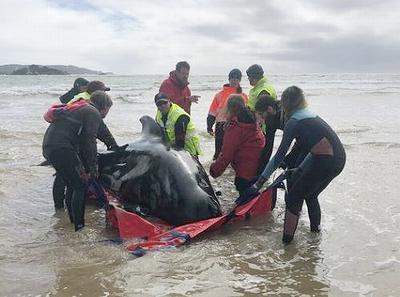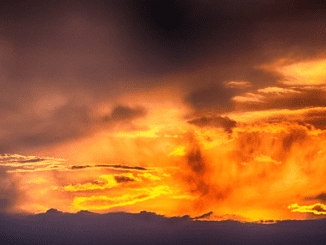
STRAHAN, Tasmania, Australia, September 28, 2020 (ENS) – Tasmanian environmental authorities are coordinating the disposal of a mass of whale carcasses after about 470 long-finned pilot whales washed ashore in the shallow waters of Macquarie Harbour on the island state’s west coast.
Marine and Safety Tasmania has issued a notice to mariners warning that whale carcasses in and near Macquarie Harbour may be drifting with the currents and wind and may create a navigation hazard.
Trained volunteers and wildlife experts were able to find at least 108 pilot whales alive in the mass of bodies along the shore and on a wide sandbank and successfully released them out to sea, marine conservationists confirmed.

Another whale was found alive today near the King River in Macquarie Harbour. This whale was rescued and successfully released out past the Macquarie Heads, but at least 380 of the long-finned pilot whales have died in the stranding incident, the worst in Australian history.
Incident Controller and Parks and Wildlife Service, PWS, regional manager Nic Deka said, “At any point in time this number is really an estimate. It is a complex site. Many of the whales are submerged and so we have made our best efforts to do the counts as we assess which animals are alive and which are dead – it is difficult,” Deka said.
About 20 animals were prioritised for rescue following an assessment Sunday morning.
Marine Conservation Program wildlife biologist Dr. Kris Carlyon said for animal welfare reasons, four whales would be euthanised following an assessment by a veterinarian.
“These are animals that we have given a chance, we tried to release them and they haven’t done well. We don’t believe trying to release them again is a viable option. The most humane course of action is to euthanise them at this stage,” Dr. Carlyon said.
Deka said the incident team working on disposal of the whales that have died, with the preference to bury the animals at sea. “Our focus in the next few days will be to try to contain the spread of carcasses because as the whales start to decompose, they will start to bloat and float and with the tides they will drift.”
“They will present a significant navigation hazard if we don’t contain them,” Deka said. He said the process would take several days. “We would like to do it as quickly as possible but unfortunately we are going to have to have the right weather conditions, tide and current conditions,” Deka said.
“We are getting really good assistance from the aquaculture industry in terms of collection and containment of the carcasses. They have been great to date in assisting with the rescue as well,” he said.
A TasPorts barge coming down from Devonport will be the main vessel used to transport the animals out to sea.
Long-finned pilot whales live in temperate and colder latitudes of the northern Atlantic Ocean and throughout the entire Southern Ocean. Not enough data has been gathered to determine whether or not they are endangered.
Tasmanian Government wildlife veterinarian Dr. Annie Philips has worked on assessing the stranded whales all week, standing in freezing water for hours. She believes she knows why the whales stranded where they did, she told the “Advocate” newspaper. “In reality,” she said, “it’s most likely the topography of Macquarie Harbour. It’s not an uncommon event for whales to be stranded there and it’s likely to happen again.”
Copyright Environment News Service (ENS) 2020. All rights reserved.



